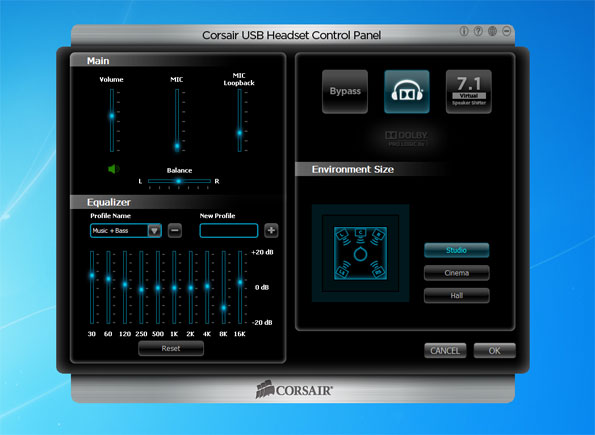Going in alphabetical order, the first up to bat is the Corsair Vengeance 1500 Dolby 7.1 USB Gaming Headset. This is Corsair's flagship USB headset, though it sports a middling price tag of $100 MSRP and around $80 street. It has a built-in DSP (Digital Signal Processor) and, as you'll see below, an aggressive design befitting a hardcore gamer looking to intimidate his foes at a LAN party.
 |
| Corsair Vengeance 1500 Dolby 7.1 USB Gaming Headset |
| Specifications & Features |
|
| Headphones |
|
Frequency Response
|
20Hz - 20kHz
|
| Impedance |
32 Ohms @ 1kHz |
| Dynamic Range |
92dB (A-weighted) |
Drivers
|
50mm |
Cable Length
|
3m |
USB power consumption
|
250mW |
Connection
|
USB Type A
|
| Microphone |
|
| Type |
Unidirectional noise-cancelling condenser
|
Impedance
|
2.2k Ohms |
| Frequency Response |
100Hz - 10kHz |
Sensitivity
|
-44db (+/-3dB)
|
| MISC |
|
Price
|
$100 MSRP (~$80 street)
|
Warranty
|
2 years
|
Design and Comfort

The hardest thing to wrap your head around with Corsair's 1500 cans is the price tag. At around $80 street, you might expect Corsair to skimp on build quality or features, but that's not the case here. This is a heavy-duty headset that comes ready to rumble with no setup required (a software download is optional). And don't worry if you're not known for your delicate touch, it would take some effort to destroy the 1500s. The gigantic ear cups attach to solid chunks of plastic that are screwed into a second layer with a brushed aluminum motif on the outside. Each ear cup swivels, a welcome feature if you're one-handing the headset like a DJ.
A thickly headband provides a layer of protection on your head for those late-night gaming sessions, and combined with the featherweight design, you can wear the 1500s comfortably for long periods of time. The headband is adjustable on each side, and with each ear cup fully extended, you could wrap these things around King Kong, with room to spare.
On the flip side, younger gamers and those with small heads might find these a bit large, even on the lowest setting, so keep that in mind if you fall into either category.
Speaking of large things, the padded ear cups themselves are rather big and feature extra-deep memory foam. These will encircle all but the biggest ears (Mr. Spock might need a custom headset, but most everyone else will be okay) and provide a bit of distance so that they're not mashed up against the sides of your head.
Inside the large ear cups are 50mm drivers. According to Corsair, the extra size compared to more common 40mm drivers allows for less distortion and more accurate sound reproduction.
Extending down on the left side is a somewhat flexible boom microphone that's adjustable with a series of clicks, just like the headband. We like that mic and headband arms click into place, which prevents you from accidentally readjusting them over time.
An in-line control module extends about a foot-and-a-half down the cable and allows you to adjust he volume up or down, as well as mute the microphone with a dedicated button. A ring surrounding each volume button glows blue when the headset is plugged in. When the microphone is muted, the rings flash red and blue. The module isn't heavy at all, though we still wish it came with a clip, which we could use to attach to our shirt for convenience.
Sound Quality
Installing Corsair's software isn't required to use the headphones, but it's definitely recommended if you want to get the most out of these cans.

Corsair's software gives you access to an equalizer with several built-in presets for music and FPS gaming. The headset sounds good without any tweaks, and even better when you custom tune the settings based on the source. As you might expect from a gaming headset, lows and mids are where the 1500s really shine. Even still, it's a serviceable solution for classical, bluegrass, and other types of music that venture into higher territories, though audio purists who are only interested in listening to music may be left a little wanting.
When we turned our attention to gaming, the 1500s perked right up and delivered bone crushing sound effects, though it largely depends on the source. In Counter Strike: Source, for example, we found ourselves getting trigger happy with the shotgun because of the satisfying blasts that emanate from the 50mm drivers. But in Duke Nukem Forever, the sound effects weren't as pronounced, in case you're one of the three people playing that game.
One neat feature of the 1500s is Virtual 7.1 surround. Through software, 5.1-channel audio gets up-mixed to a virtual 7.1 sound stage to help with positional audio. We never felt the need to use it, as the 5.1-channel audio does a good job of letting you know when a enemy is sneaking up your six, but it's there nonetheless.











